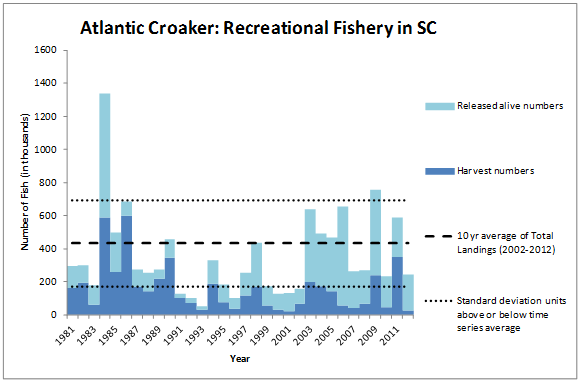Marine - Species - Atlantic Croaker
Recreational Fishery in SC

The long-term trends for Atlantic croaker showed an overall decline from the mid-1980's through the mid-1990's after which total catch increased into the 2000's. The number of croaker harvested has decreased throughout the time series while the number of fish released alive has increased. This likely reflects the trend in recent years toward catch and release angling.
Atlantic croaker have been reported as a commercial species in South Carolina, however there were only 18,936 lbs reported from 1981 through 2009 and these fish made up significantly less than 1% of the total catch for all states in the southeastern US (FL, GA, SC, NC). The majority of commercially caught Atlantic croaker are by-catch from shrimp trawlers (NMFS, 2013). Atlantic croaker are a major component of the by-catch in the southern shrimp trawl fishery but there have been few studies estimating the magnitude of the impact of the shrimp trawl fishery in the southeastern US.
The recreational catch data is provided by the National Marine Fisheries Service (NMFS), which conducts phone and angler-intercept surveys to monitor angler activities and catches. For more information see: https://www.st.nmfs.noaa.gov/.
The commercial fisheries data is provided by the National Marine Fisheries Service (NMFS), which compiles commercial information provided by state agencies. For more information, see: https://www.st.nmfs.noaa.gov/.
Additional Graph Information
Commercial and recreational catches are measured in number of individuals or pounds of fish caught. Changes in catch among years may be the result of changes in abundance, fishing effort, or a combination of the two.
On each graph, the horizontal dotted lines above or below the "10 year average" represent one "standard deviation" unit, which is a measure of how variable the annual data are around the 10-year average. In general, the area between one standard deviation above the mean and one standard deviation below the mean includes approximately 68% of all values. Approximately 95% of observations in the data set are found within two standard deviation units of the average and is referred to as the prediction interval.
